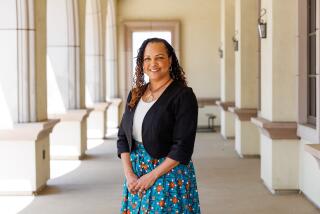Plight of Disabled Children Told : Speakers Urge U.S. Panel to Back Normal Social Settings
- Share via
Stephen Brees, 32, knows what he’s talking about when he familiarizes disabled elementary school children with non-disabled ones in the Fountain Valley School District.
It’s his job. And Brees, who received his master’s degree in psychology last summer from Cal State Fullerton, also has first-hand experience. He has cerebral palsy.
When he was 3, Brees was sent to a special education school. At 16, Brees entered a “regular” high school, where he was able to interact with non-disabled students. Although he will always require an assistant to help with the most basic needs, Brees hopes he will eventually be able to assume financial responsibility for himself.
Witness Before Committee
“I am convinced that whatever social benefit I may be to my community is largely possible because of the relationships I have had and still have in educational and vocational settings,” he said Friday.
Brees was one of several witnesses at the Hilton Towers hotel in Anaheim testifying before the Select Committee on Children, Youth and Families.
The committee was formed to examine the problems faced by families with disabled children. It will make recommendations to Congress later this year.
Committee members were told that financial support for disabled students should be redirected to families and communities and away from institutions.
A Difficult Choice
Some parents of disabled children testified that they had to choose between caring for their children at home and trying to integrate them into the public school system or placing them in private care homes.
Beverly Bertaina, of Sebastopol, Calif., whose son Adam, 12, has cerebral palsy, profound retardation and seizures, said, “It took two years and a fair hearing to get Adam into an integrated program, but it is 15 miles and a one-hour bus ride away.
“Do we ruin ourselves financially or place our kids? It’s a terrible quandary. It is an amazing paradox that institutional care for Adam would cost $35,000 to $65,000 per year but the federal and state government are willing to spend only $2,000 to $3,000 per year to help us keep Adam at home,” Bertaina said.
According to the Disability Rights Education and Defense Fund, in-home care for a severely disabled child in 1984 cost $7,000 to $8,000 a year, compared with $38,000 to $40,000 annually for institutionalizing that child.
A Double Problem
Mary K. Short of Fountain Valley is the mother of a 5 1/2-year-old severely handicapped daughter. While caring for her daughter at home, she has had to contend with non-support from her ex-husband.
“I have been divorced since August, 1981. (The father of her child) has been on probation for non-support since December, 1982, . . . . He currently is $5,050 in arrears in the child support payments.”
Short said her daughter is temporarily in a private care home until she can earn enough money to hire live-in help.
“For those of us who for whatever reason, do have our children placed (in a home), the system is beautifully efficient. The systems for in-home and out-of-home handicapped children need to be equalized.”
More to Read
Sign up for Essential California
The most important California stories and recommendations in your inbox every morning.
You may occasionally receive promotional content from the Los Angeles Times.













